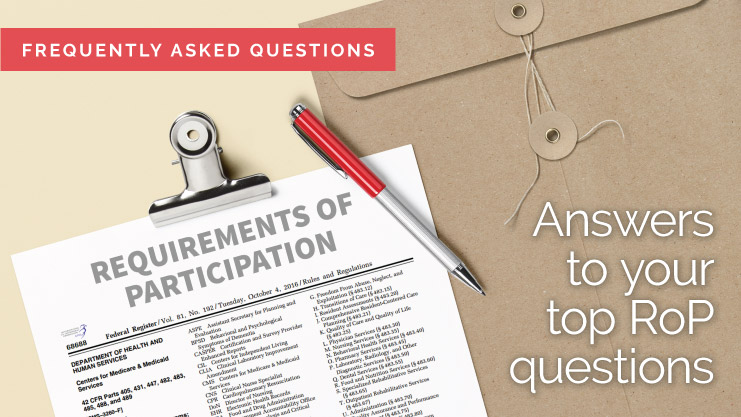On Mar. 7, SimpleLTC and Briggs Healthcare presented one of our most popular training webinars ever: “The RoPs are here! Do you know what’s changing?”
The new CMS Requirements of Participation (RoPs) — also known as the “Mega Rule” or “Final Rule” — became effective Nov. 28, 2016, and represent the first comprehensive changes made to the requirements for long-term care providers participating in the Medicare and Medicaid programs since 1991.
Hundreds of participants asked dozens of questions during the webinar, but we couldn’t cover them all due to time restraints. We’ve now worked with our speaker, Mary Madison of Briggs Healthcare, to get answers to all the RoP questions. We’re publishing them here as a service to LTC providers.
Where can I find the latest information about Appendix PP (including the Mar. 8, 2017 changes)?
CMS has revised Appendix PP once again on March 8, 2017. There are changes to 29 F-tags as well as Effective and Implementation dates. This updated Appendix PP is found here. I encourage all to go to this latest transmittal and use this as their guide. I am certain that we will have more revised Appendix PPs – even before the final Interpretive Guidance is released. Keep watching!
Can a PA or NP dictate dietary orders or is it only a physician?
The following falls under F390:
483.30(e) Physician delegation of tasks in SNFs. §483.30 (1) Except as specified in paragraph (e)(4) of this section, a physician may delegate tasks to a physician assistant, nurse practitioner, or clinical nurse specialist who— (i) Meets the applicable definition in §491.2 of this chapter or, in the case of a clinical nurse specialist, is licensed as such by the State; (ii) Is acting within the scope of practice as defined by State law; and (iii) Is under the supervision of the physician.
Check with your state licensing agency to be sure as this could vary from one state to another. It certainly is allowed Federally.
Can you give an example of something that might be willful but not intended actions?
Here’s one example: A resident with dementia becomes agitated during a tub bath and wants to get out of the tub and resists the CNA’s attempt to finish the bath. The CNA slaps the resident across the face. The slap did not happen by chance — it was deliberate. The new abuse definition found at §483.5 (F150) classifies the action as abuse — the CNA deliberately or willfully struck the resident even though she did not intend to inflict injury or harm.
Must facilities allow visitation even after a curfew of 10:00pm? One of our residents wants visitors at 11:00pm, 12:00am, 1:00am.
The short answer is that the resident makes the choice on hours of visitation in as much as such visitation at those hours does not impose on the rights of other residents. In addition, the facility must have policies and procedures regarding visitation that address clinical necessity and safety when limits or restrictions are imposed. If you can find a way to allow the resident to receive visitors at that hour that maintains the safety and rights of other references, you should make those accommodations.
Regulatory references:
§483.10(f)(4) The resident has a right to receive visitors of his or her choosing at the time of his or her choosing, subject to the resident’s right to deny visitation when applicable, and in a manner that does not impose on the rights of another resident.
§483.10(f)(xi) – The facility must have written policies and procedures regarding the visitation rights of residents, including those setting forth any clinically necessary or reasonable restriction or limitation or safety restriction or limitation, when such limitations may apply consistent with the requirements of this subpart, that the facility may need to place on such rights and the reasons for the clinical or safety restriction or limitation.
Do the ROPs apply to a 20-bed short-term rehab facility?
No — they only apply to long-term care facilities.
Do we need paper copy of actual signatures of attendees at care conferences or can we electronically enter who attended the care conference in our care conference note?
There is no specific reference in the existing Interpretive Guidance that addresses requirements for attendees actually signing or their presence being noted in a specific medical record entry. The IGs that will be released later this year may speak to this. In the interim, I would follow your current facility policy on attendance.
Do we need to have the resident or resident’s representative sign their care plan, or offer them to sign the care plan if they choose?
My short answer is yes – I would recommend having the resident or the resident’s representative sign their care plan. Because this final rule speaks to regulatory changes and CMS initiatives to move towards person-centered care, it would seem appropriate to have the resident sign the care plan.
See item (v) of this regulation behind F280:
483.10(c)(2) The right to participate in the development and implementation of his or her person-centered plan of care, including but not limited to: (i) The right to participate in the planning process, including the right to identify individuals or roles to be included in the planning process, the right to request meetings and the right to request revisions to the person-centered plan of care. (ii) The right to participate in establishing the expected goals and outcomes of care, the type, amount, frequency, and duration of care, and any other factors related to the effectiveness of the plan of care. (iv) The right to receive the services and/or items included in the plan of care. (v) The right to see the care plan, including the right to sign after significant changes to the plan of care. When CMS releases the Interpretive Guidance, we should see verbiage that speaks to resident signature indicating acknowledgement and agreement with the plan of care.
Do we need to notify the ombudsmen regarding hospital ER visits?
I don’t find evidence in Appendix PP/the RoPs overall where the facility must notify their state LTC Ombudsman of a resident’s transfer to the emergency department. §483.15(c)(3) seems to speak to this notification needing to be made if/when the resident is transferred or discharged involuntarily – safety, behavior issues, facility closing, etc. The current verbiage in Appendix PP (remember we do not yet have the Interpretive Guidance verbiage for the revised regulatory text) seems to point to those instances and not transfers and discharges for personal or medical reasons. I have asked for clarification and have not yet received anything. I would recommend that you contact your state survey agency for clarification.
Does this include CAH swing beds?
These RoPs do not apply to CAHs (Critical Access Hospitals). CAHs have their own Conditions of Participation found in Appendix W of the State Operations Manual.
Has CMS made any comments in regards to whether any of these changes will affect reimbursement? In other words, will SNFs get more $$/day to cover some of the new costs?
The Final Rule contains this statement:
“We also recognize that there are additional initiatives taking place within the industry that fall outside the requirements in the regulation and will have an impact on LTC facilities including SNF reimbursement. However, as noted previously SNF PPS payment rates have increased steadily over recent years, due to market basket updates. In addition, the cost associated with operating a business that is in compliance with the requirements for LTC facilities is the responsibility of the facility.”
Have you seen PTSD documented on charts, by physicians, with certain diagnoses? Are there resources/documentation available to train our team?
In my practice, I have indeed seen PTSD diagnoses, particularly with elder veterans. The RoPs [F319 – §483.25(m) and F320 – §483.40(b)(2)] require trauma-informed care which includes PTSD but also speaks to other traumas as well. This falls under the umbrella category of behavioral health. Implementation of this occurs in both Phases 2 and 3 with the facility assessment being conducted in Phase 2. I recommend contacting mental/behavioral health resources in your community to provide training as this is their area of expertise (hospitals, mental health centers, etc.) At the present time, there is no definitive training resource available within Appendix PP.
How would a survey find “proof” that the pharmacist reviewed the medical chart?
I would expect that the surveyor will look for a specific form or documentation by a pharmacist that he/she reviewed the resident’s medical record as part of the Drug Regimen Review. CMS rarely dictates a format for doing this, so your facility can set their policy and procedure to include the review of the medical record with each DRR. However that is done, be sure that it specifies the review of the medical record and that documentation reflects that.
If a voluntary discharge, is the standard NOMNC form sufficient for notification, even if not delivered two days prior?
When a resident chooses to end their own skilled stay, they are not eligible for NOMNC (Notice of Medicare Non-Covered Services). This notice is designed to provide their rights for expedited appeal when the facility/physician opts to end their covered stay. If your question is about providing written notice of transfer/discharge (and without knowing more specifics of your question), I recommend that you contact your state survey agency to confirm whether this requirement is necessary in cases other than involuntary transfer/discharge from the facility.
If we have rooms with 3-4 beds to a room and no showers/private toilets, do these need to be changed only during a major reconstruction or is there an end date when these need to be removed regardless of reconstruction?
The following is all that I can find regarding this question. I recommend that you contact your state survey agency for additional clarification if needed.
483.90 (e)(1)(i) Accommodate no more than four resident. Facilities that receive approval of construction or reconstruction plans by State and local authorities are newly certified after November 28, 2016, bedrooms must accommodate no more than two residents. [F457].
Is there a calculation based on activities required that CMS has made available for explaining the cost estimate of $60-70K per year?
Here’s a direct quote from the Final Rule published in the Federal Register on 10/4/2016:
3. SUMMARY OF COSTS AND BENEFITS…We estimate the total projected cost of this final rule will be about $831 million in the first year and $736 million per year for subsequent years. While this is a large amount in total, the average costs per facility are estimated to be about $62,900 in the first year and $55,000 per year for subsequent years. Although the overall magnitude of cost related to this regulation is economically significant, we note that these costs are significantly less than the amount of Medicare and Medicaid spending for LTC services. According to the 2015 Annual Report of the Medicare Trustees, payments for SNF services from Medicare Part A were $29.92 billion for fiscal year 2015 and payments for NF services were $50.6 billion for fiscal year 2013.
An interesting resource comes from AHCA members that is based on comprehensive research and reflects member feedback and input. The submission also includes estimated cost tables.
What are other acceptable ways to include physician when they can’t/won’t come to the IDT meeting (e.g., rural facilities)?
The current Interpretive Guidance (remember CMS is not going to publish the updated IG relative to the updated regulatory text until later this year) says this:
“The physician must participate as part of the interdisciplinary team, and may arrange with the facility for alternative methods, other than attendance at care planning conferences, of providing his/her input, such as one on-one discussions and conference calls.”
As a seasoned practitioner, I do not anticipate much if any change to this IG but do stay tuned in case CMS has different ideas on this. Having worked in rural LTC facilities, I incorporated the plan of care review with the physician when orders were renewed as well as during physician visits to the resident in the facility.
Our Dietary Supervisor attended an approved certification program prior to hire several years ago. We are currently in survey and CDPH states that this program is not sufficient to meet the RoP change. Can you explain what constitutes a certified dietary manager? (We are in California.)
I recommend that you view this flyer for the information you’re looking for. This is newly posted information and appears to be exactly what you’re looking for. You can also contact the Association of Nutrition and Foodservice Professionals (ANFP) with additional questions.
To what extent are we required to meet a single resident’s request, for example, authentic Mexican foods?
I recommend doing your best to meet the resident’s preferences re: food. Serving 100% authentic ethnic food may not be feasible, so involve the resident in conversations/negotiations on how often this can be accomplished. Could family/friends provide such foods for special occasions? Learn more about the resident and his/her preferences – perhaps this is a request for just a few specific items. The bottom line is to talk to the resident and see what can be worked out. The current Interpretive Guidance for F162 says: If the resident requests and receives food that is either not commonly purchased by the facility or easily prepared, then the facility may charge the resident. You likely will not want to do this for every meal — that would raise eyebrows unless that is the resident’s choice and there is no room for negotiation.
What qualifications are needed to become an Infection Control Preventionist?
The IP must:
(1) Have primary professional training in nursing, medical technology, microbiology, epidemiology, or other related field; (2) Is qualified by education, training, experience or certification; (3) Works at least part-time at the facility; and (4) Has completed specialized training in infection prevention and control.
When the publication of the SOM came out there was a provision under hospice services that the LTC facility must designate a care coordinator between the facility and hospice. Can you speak a little about that and give a date of implementation for this previously undisclosed section?
Below is what the new RoP says. This is implemented in Phase 1.
483.70(o)(3) Each LTC facility arranging for the provision of hospice care under a written agreement must designate a member of the facility’s interdisciplinary team who is responsible for working with hospice representatives to coordinate care to the resident provided by the LTC facility staff and hospice staff. The interdisciplinary team member must have a clinical background, function within their State scope of practice act, and have the ability to assess the resident or have access to someone that has the skills and capabilities to assess the resident.
The designated interdisciplinary team member is responsible for the following:
(i) Collaborating with hospice representatives and coordinating LTC facility staff participation in the hospice care planning process for those residents receiving these services.
(ii) Communicating with hospice representatives and other healthcare providers participating in the provision of care for the terminal illness, related conditions, and other conditions, to ensure quality of care for the patient and family.
(iii) Ensuring that the LTC facility communicates with the hospice medical director, the patient’s attending physician, and other practitioners participating in the provision of care to the patient as needed to coordinate the hospice care with the medical care provided by other physicians.
(iv) Obtaining the following information from the hospice:
(A) The most recent hospice plan of care specific to each patient.
(B) Hospice election form.
(C) Physician certification and recertification of the terminal illness specific to each patient.
(D) Names and contact information for hospice personnel involved in hospice care of each patient.
(E) Instructions on how to access the hospice’s 24-hour on-call system.
(F) Hospice medication information specific to each patient.
(v) Hospice physician and attending physician (if any) orders specific to each patient.
(vi) Ensuring that the LTC facility staff provides orientation in the policies and procedures of the facility, including patient rights, appropriate forms, and record keeping requirements, to hospice staff furnishing care to LTC residents.
Where can I purchase or download the Feb. 10, 2017 Appendix PP/Interpretive Guidance?
There are actually two questions here:
- You can download Appendix PP at no charge here. (This is the most current version.) This link brings you to the most recent version of this Appendix in terms of regulatory changes (in red). NOTE: The Interpretive Guidance is NOT included in this Appendix PP – that is expected “later this year.” Because that portion of the RoP is not available yet, it cannot be downloaded or purchased.
- Briggs Healthcare has a Survey Guide available for purchase here. You will note three different versions, depending on which update subscription option you choose. Your state LTC association as well as other vendors also have the State Operations Manual available for purchase. Appendix PP is one part of the SOM.
Would a statement on the POS indicating that the care plan has been reviewed by the MD be sufficient since the MD must sign the MDS?
The physician is not required to sign the MDS unless he/she completed any item or section on the MDS (usually the physician does not). There is nothing in the RAI Manual that mandates that the physician sign the MDS. It would be inappropriate to do so in Section Z unless the physician did gather data or complete an item or section of the MDS. The physician is considered part of the Interdisciplinary Team (IDT) and thus must be aware of the resident’s plan of care. Some facilities include a statement on the recertification of orders that the physician is aware of and agrees with the resident’s plan of care. This is what I did in my clinical practice, plus I made sure the physician either: a) received a copy of the current care plan, or b) showed the care plan to the physician when he/she visited or examined the resident.





4 Comments on “RoP questions? We’ve got answers in this FAQ”
Helpful content. Thanks. I am looking for options regarding the requirement to provide a summary of the baseline care plan to the resident/representative. It is supposed to include goals of care, summary of medications and dietary instructions, services and treatments. In our EMR, the orders populate on the care plan and these can be very extensive and not practical to give to a resident. So other options would be appreciated.
Thanks, Judy — You can print it from your browser by hitting Ctrl-P and selecting a printer.
can you please clarify for me if the RoP’s apply to NON CAH hospitals, we are a 6 bed swing bed unit in a rural hospital, I have particular questions about the Facility self assessment, do we need to complete this? do you have any resources on this if so? Do you know where I can look for specific NON cah swing bed RoP’s and guidelines ?
thank you very much
Per one of our Briggs Healthcare clinical experts: The Final Rule (2016-23503) says this about swing beds:
For those health care providers who are not sure whether these requirements apply to them, we encourage them to work with their facility’s administration and governing body to determine applicability. This rulemaking applies to Medicare- and Medicaid-certified long term care facilities as defined at sections 1819 and 1919 of the Act and all facilities receiving payment under such programs. Swing-bed hospital units, for example, would need to meet specific conditions of participation for such units, as set out at 42 CFR 482.58, and which include a subset of the requirements contained 42 CFR 483.
The regulatory links above say nothing about the facility assessment in either of these resources. §483.70(e) is the regulatory reference to the facility assessment. Best advice is to contact your State Agency!
https://www.cms.gov/Medicare/Medicare-Fee-for-Service-Payment/SNFPPS/SwingBed.html is the link to the CMS website for swing bed providers.
https://www.cms.gov/Regulations-and-Guidance/Guidance/Manuals/downloads/som107ap_t_swing_beds.pdf is the link to Appendix T of the State Operations Manual (SOM). This Appendix was last updated April 2015.